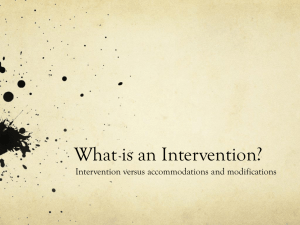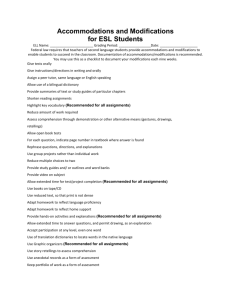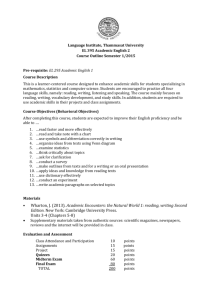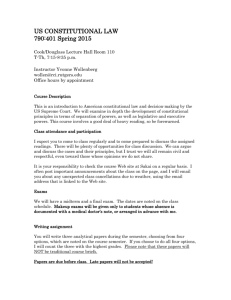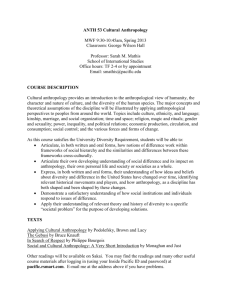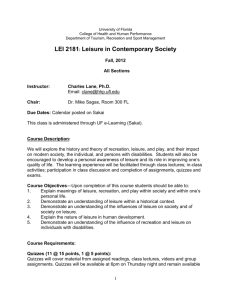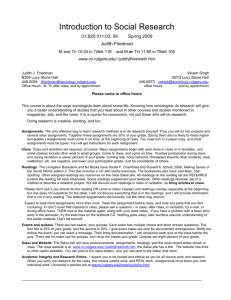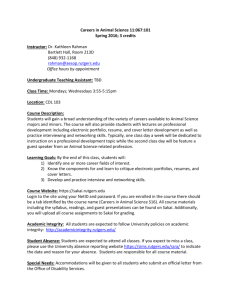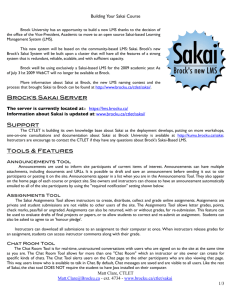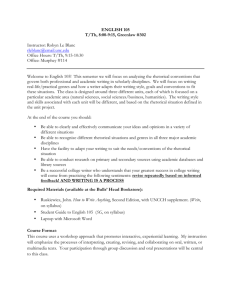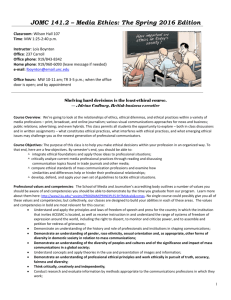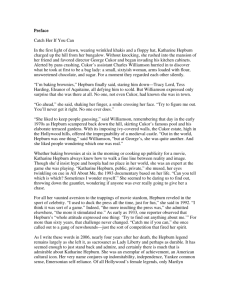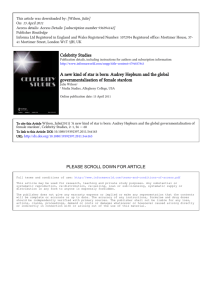ECON 251: INTERMEDIATE MICROECONOMIC THEORY ST
advertisement
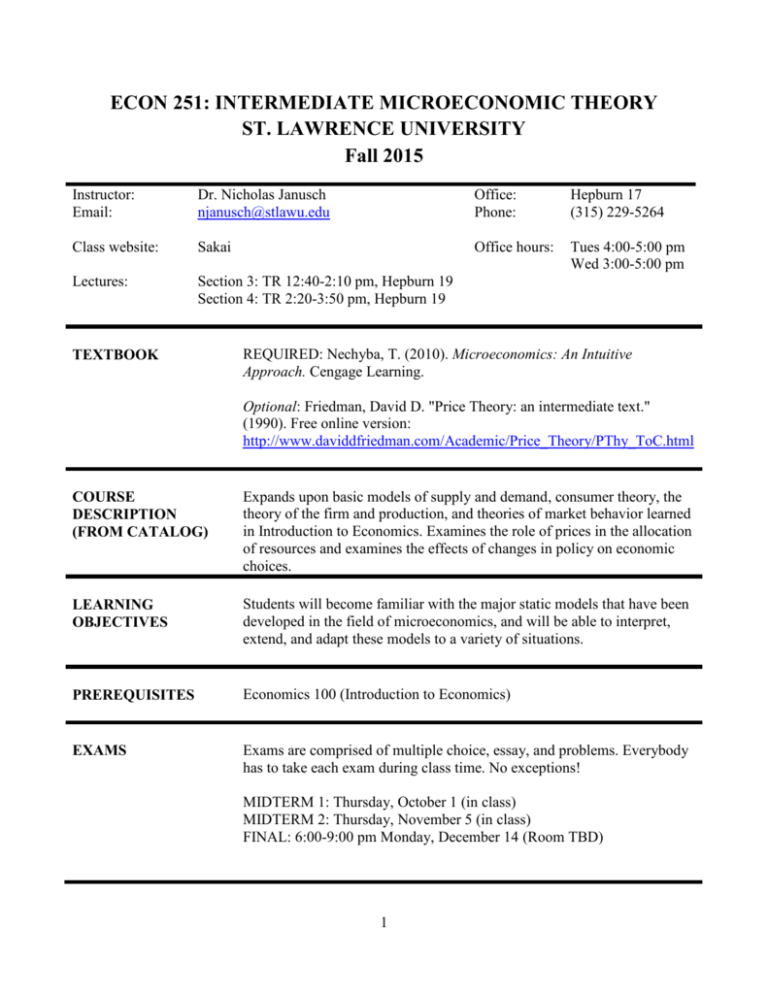
ECON 251: INTERMEDIATE MICROECONOMIC THEORY ST. LAWRENCE UNIVERSITY Fall 2015 Instructor: Email: Dr. Nicholas Janusch njanusch@stlawu.edu Office: Phone: Hepburn 17 (315) 229-5264 Class website: Sakai Office hours: Tues 4:00-5:00 pm Wed 3:00-5:00 pm Lectures: Section 3: TR 12:40-2:10 pm, Hepburn 19 Section 4: TR 2:20-3:50 pm, Hepburn 19 TEXTBOOK REQUIRED: Nechyba, T. (2010). Microeconomics: An Intuitive Approach. Cengage Learning. Optional: Friedman, David D. "Price Theory: an intermediate text." (1990). Free online version: http://www.daviddfriedman.com/Academic/Price_Theory/PThy_ToC.html COURSE DESCRIPTION (FROM CATALOG) Expands upon basic models of supply and demand, consumer theory, the theory of the firm and production, and theories of market behavior learned in Introduction to Economics. Examines the role of prices in the allocation of resources and examines the effects of changes in policy on economic choices. LEARNING OBJECTIVES Students will become familiar with the major static models that have been developed in the field of microeconomics, and will be able to interpret, extend, and adapt these models to a variety of situations. PREREQUISITES Economics 100 (Introduction to Economics) EXAMS Exams are comprised of multiple choice, essay, and problems. Everybody has to take each exam during class time. No exceptions! MIDTERM 1: Thursday, October 1 (in class) MIDTERM 2: Thursday, November 5 (in class) FINAL: 6:00-9:00 pm Monday, December 14 (Room TBD) 1 HOMEWORK You will be given 12 weekly homework assignments, excluding exam weeks. Your 10 best scores will count towards your final weighted grade. The homework accounts for 35% of your grade and is meant to be CHALLENGING! You will not be able to begin them the evening before they are due and complete the assignments for class. Homework assignments will have components that require you to address some question using the graphical tools developed in class and the text as a way to understand and present economic theory. Additionally, you will be asked to analyze the model you have been presented to address some questions verbally. These answers must be presented in complete sentences or paragraphs. “Yes,” even if the correct answer, will not be evaluated as an acceptable answer. Each homework question (and sub-question within a problem) will be graded on a scale of 2 (all correct), 1 (partially correct), and 0 (incorrect). Your homework grade will be based on the percentage of available points that can be earned on an assignment. For example, if there are 10 problems then there are 20 available points, if your earn 15 of these, your homework grade is 7.5 out of 10. Working in groups is encouraged but the final product must be your own work. Homework assignments and solutions will be posted on Sakai. Graded homework may not have thorough feedback, so students are encouraged to compare their scored homework to the homework answer keys. Assignments must be stapled. One point will be deducted for the first offense if assignment is turned in un-stapled, two points for the second offense, etc. No late homework will be accepted. ATTENDANCE We are all adults here. Attendance is not evaluated but is expected and strongly recommended. Missing class may result in losing the opportunity to make (small amounts of) extra credit points. Please silence your cell phones and similar devices before class! Please avoid texting or checking and updating your social network during class. It is rude to me and others if I see you do it, so let us try to act professionally. GRADES* The final grade is based on your weighted average of homework and three exams. The weights are as follows: Homework Midterms (2) Final Exam 35% 40% 25% 2 GRADES* (CONTINUED) The grading scale will be no stricter than Grade 4.0 3.75 3.5 3.25 3.0 2.75 2.5 2.25 2.0 1.75 1.5 1.25 1.0 0 Percent 95-100 91-94 88-90 85-87 82-84 79-81 76-78 73-75 70-72 67-69 64-66 61-63 55-60 0-54 Your final grade will be calculated from the grades posted on Sakai. It is your responsibility to check the grades posted on Sakai to make sure they are correct. Your grade will be determined as stated in this syllabus, not as Sakai calculates for you. *Grading scale is subject to change. CHEATING AND ACADEMIC DISHONESTY Don’t do it! All students are expected to adhere to the academic honor policy outlined in the Constitution of the Academic Honor Council. An online copy of the constitution can be found at http://www.stlawu.edu/sites/default/files/resource/AcademicHonorPolicy.pdf ACCOMMODATIONS FOR STUDENTS WITH DISABILITIES If you have a disability and need accommodations please be sure to contact the Disability and Accessibility Services Office (x5537) right away so they can help you get the accommodations you require. If you will need to use any accommodations in this class, please talk with me within the first two weeks of the semester so you can have the best possible experience this semester. Although not required, I would like to know of any accommodations that are needed at least 10 days before a quiz (focus question) or exam, so please see me soon. For more specific information visit the DASO website http://www.stlawu.edu/disability-andaccessibility-services 3 COURSE OUTLINE** (TENTATIVE) Section 1–THEORY OF THE CONSUMER • Introduction (In-class Review, Chapter 1) • A Consumer’s Economic Circumstances (Chapter 2) • Tastes and Indifference Curves (Chapter 4) • Different Types of Tastes (Chapter 5) • Doing the “Best" We Can (Chapter 6) • Income and Substitution Effects in Consumer Goods Markets (Chapter 7) • Consumer Surplus and Deadweight Loss (Chapter 10) Section 2–THEORY OF THE FIRM • One Input and One Output: A Short-Run Producer Model (Chapter 11) • Production with Multiple Inputs (Chapter 12) • Production Decisions in the Short and Long Run (Chapter 13) Section 3 – PERFECT COMPETITION & SPECIAL TOPICS Selected sections in the following chapters (As time permits) • Competitive Market Equilibrium (Chapter 14 & In-Class Market Experiment) • Asymmetric Information in Competitive Markets (Chapter 22 & In-Class Market Experiment) • Monopoly (Chapter 23) • Strategic Thinking and Game Theory (Chapter 24) • Public Goods (Chapter 27) • Externalities in Competitive Markets (Chapter 21) **The schedule of topics is subject to change 4 Course Schedule* Tues. Thurs. Book Chapters Nechyba (Tentative) Notes 8/28 Math Refresher (Hepburn 218 from 1pm-2pm) Optional, but attendance will be taken Week 1 (8/27) First Day 1 Week 2 (9/1 and 9/3) HW 1 1, 2 Week 3 (9/8 and 9/10) HW 2 4, 5 Week 4 (9/15 and 9/17) HW 3 5, 6 Week 5 (9/22 and 9/24) HW 4 6, 7 Week 6 (9/29 and 10/1) Midterm 1 7 Week 7 (10/6 and 10/8) HW 5 10, 11 No Class 11 Mid-semester Break Week 9 (10/20 and 10/22) HW 7 12 Optional: Chapter 9 (Friedman) Week 10 (10/27 and 10/28) HW 8 12, 13 Optional: Chapter 9 (Friedman) Week 11 (11/3 and 11/5) Midterm 2 13 Week 12 (11/10 and 11/12) HW 9, ICE 1 14 Week 13 (11/17 and 11/19) HW 10, ICE 2 14, 22 -- -- Week 14 (12/1 and 12/3) HW 11 23, 24 Week 15 (12/8 and 12/10) HW 12 27, 21 Week 8 (10/13 and 10/15) Thanksgiving Break (11/24 and 11/26) Finals Week HW 6 -- We are skipping Chapter 3 We are skipping Chapters 8 & 9 -- Final Exam: Monday, December 14, 6:00 pm - 9:00 pm (Room TBD) HW = Homework Assignment; ICE = In-class Experiment *Subject to change based on the needs of the class 5
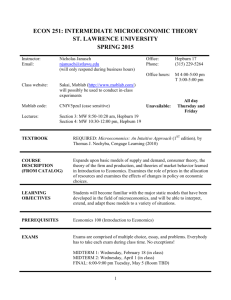


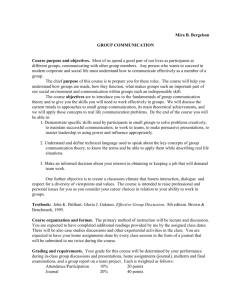


![Syllabus [Word]](http://s3.studylib.net/store/data/006967311_1-8dc868a12812e520f131dbbe02cc269a-300x300.png)
